
Making Space at the Table
NAP Contemporary’s group show, The Elephant Table, platforms six artists and voices—creating chaos, connection and conversation.

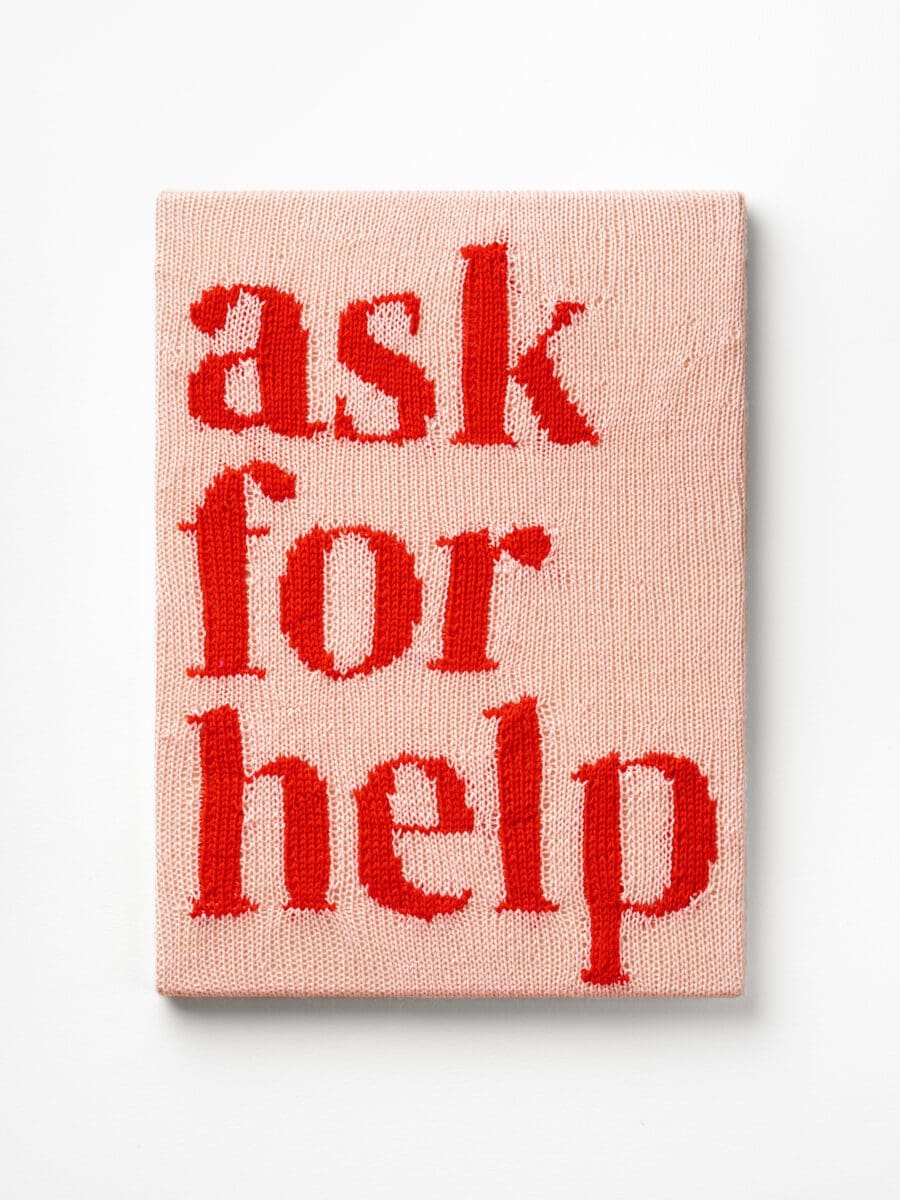
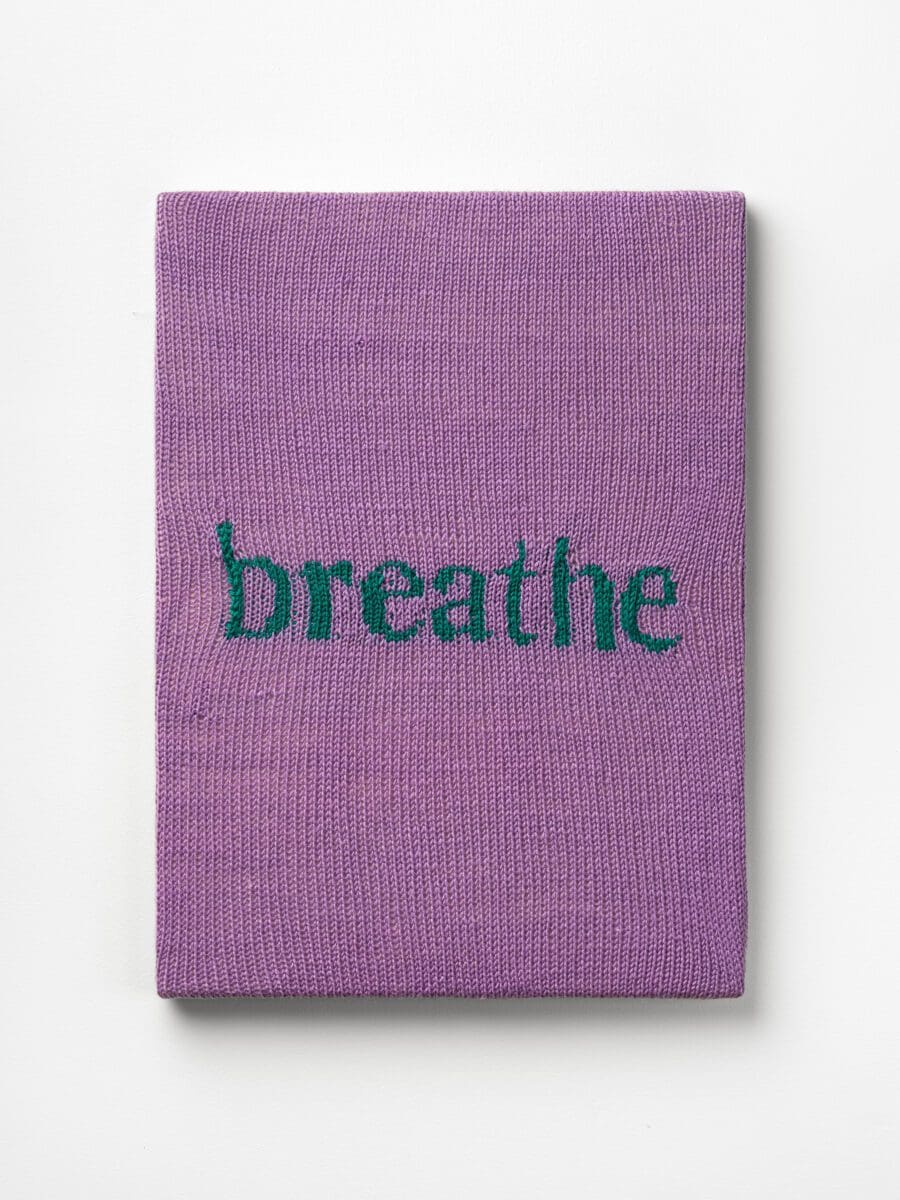
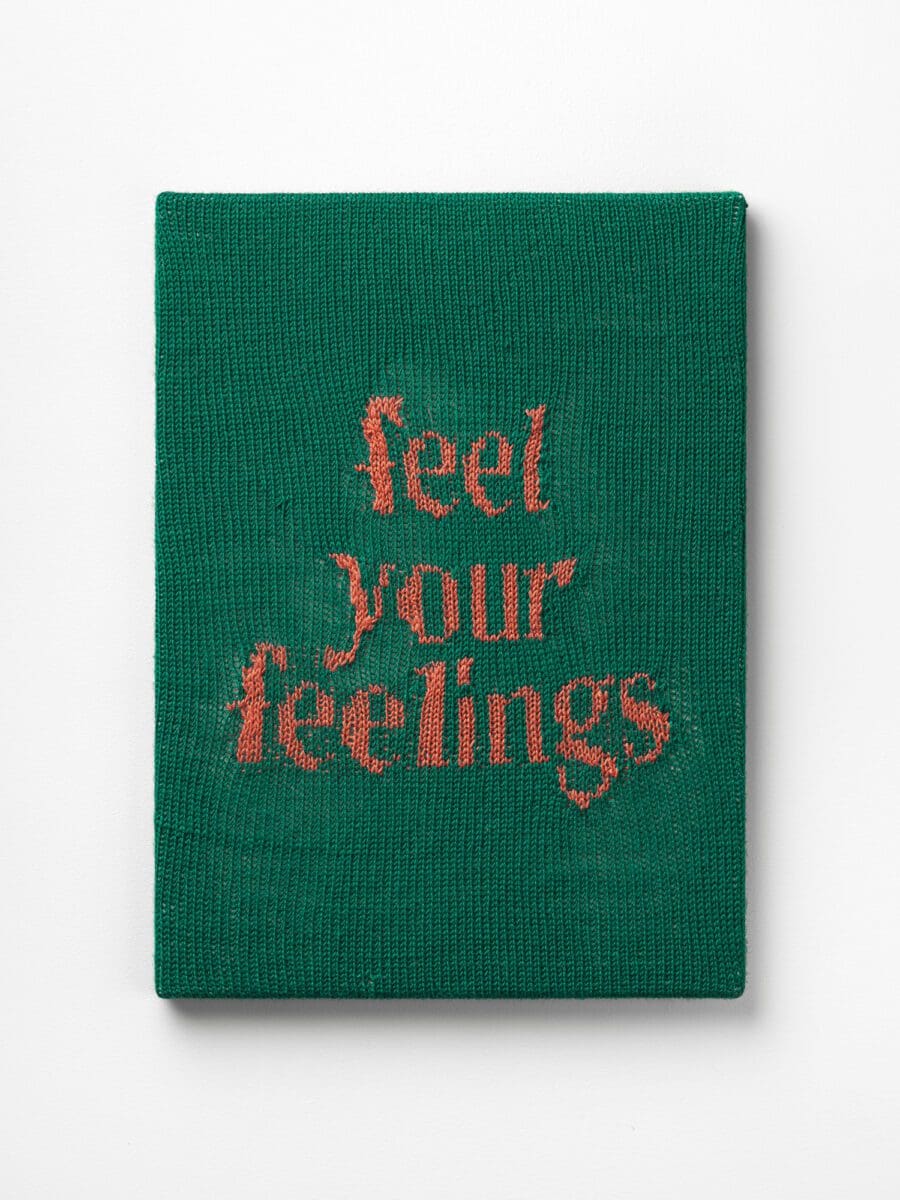

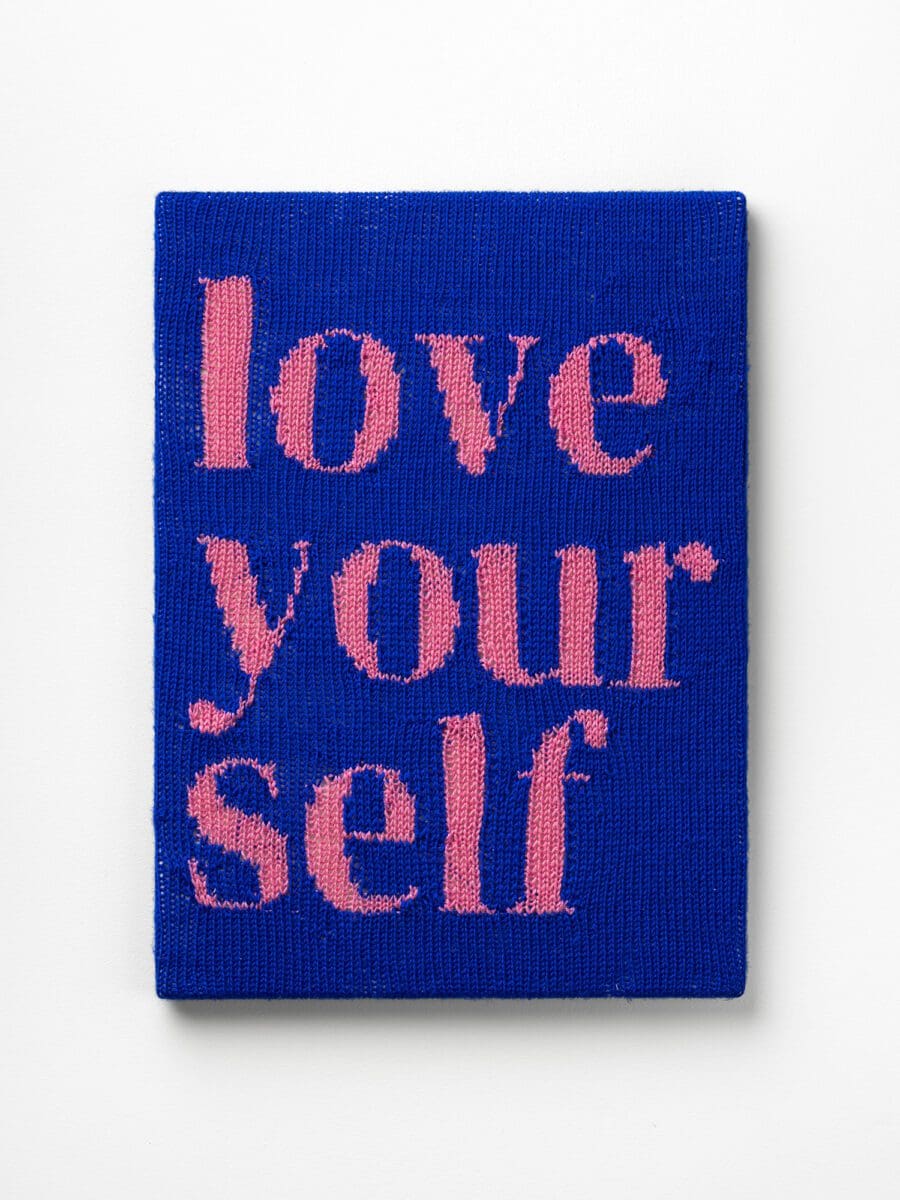


“Anonymous was a woman” was once stitched by Kate Just into 140 knitted works in bold colours. While her queer, feminist and social justice practice has spanned largescale knitted sculptural and pictorial works, as well as collage and digital prints, in recent years she has been knitting protest signs and homages to her favourite feminist artists. For her latest Self Care Action Series, Just has knitted texts revealing her own self-care tools like “get therapy”, “make art” and “learn something new”. We asked Just 20 questions about these works and her wider practice.
First art love?
Both Jean-Michel Basquiat and Frida Kahlo. Painting was my first medium, and as a young artist I was drawn to these artists who inscribed their work with both a deeply personal vision and a critique of societal issues.
How and when did you first start knitting?
I began knitting in 2000 after the tragic loss of my brother. In a moment of grief, my mother sat beside me and taught me to knit. In that moment, I understood knitting to be a powerful personal tool for narrating stories and creating new bonds.
Do you have a favourite word or phrase that has appeared in your work?
My favourite phrases include Anonymous was a woman, Keep your laws off my body, Feel Your Feelings and We’ll Be Less Activist if You Be Less Shit. My favourite words are LOVE and HOPE.
If you could collaborate with any artist who would it be?
I love collaborating with communities of people and rarely collaborate with solo artists. If I could collaborate with anyone, it would be the Guerrilla Girls.
Best colour to create with?
I love all the bright colours, but my favourite is yellow. I’m about to make a giant yellow work called Conversation Piece. I love the jubilance of yellow.
Order or chaos?
Order!
The most interesting thing someone has said to you about your work?
A dock worker in Sydney stopped into the Museum of Contemporary Art on a break, and stopped in front of my work Anonymous was a woman. He was so engaged that he sat in a knitting circle for an hour, reflecting in a very vulnerable and open way on his role as a father to a young daughter. After sitting in a circle with me and other women, he left with a different approach to affirming and encouraging his young daughter’s freedom and power. It was very moving.
You’ve recently knitted your Self Care Action Series featuring ideas that you find important for self-care. How did this come about?
I was tired and jaded from years of fighting for structural and political change, often to no effect. And I started thinking about how to care for one’s self in very challenging times. I made a list of my own tools for self-care. Right as the series started, my father died, and I started to feel that I needed these knitted works more than ever to move through grief.
What does self-care mean to you?
Self-care means making space for the actions that support my well-being. These actions ultimately come from understanding myself—what I want and need my life to look like. This involves how I spend my time, make space for rest and joy, and what boundaries I can put in place to look after myself and sustain my energy and creativity. It’s about looking after myself so I can also care for others and thrive creatively. I wanted to share these ideas with others, and other artists especially, because it is powerful for each of us to work out how we replenish our energy, in this one life we have to live!
You’ve talked about the radical history of self-care and its relevance to feminist practice—could you explain this more?
Self-care has its roots in radical activism. The term dates to the United States-based civil rights and women’s rights movements of the 1960s and 1970s. In the late 1960s, the Black Panther Party created the first Peoples’ Free Medical Clinic. The women’s rights movement in the 1970s also created feminist health centres. These activists were talking about self-care within their own communities and modelling the practice. Writer, feminist, and civil rights activist Audre Lorde stated: “Caring for myself is not self-indulgence, it is self-preservation, and that is an act of political warfare.”
On Instagram you’re selecting one of your Self Care Actions, like “grieve” or “accept care”, and telling the story behind that work. It’s genuinely helpful and interesting. Why did you decide to divulge the stories like this?
For the last eight years, I have been using Instagram to share projects and personal narratives about my work. I like sharing knitted works on social media because it counteracts the speedy scroll culture with images of hand-knitted work made over a long time with a lot of care and attention. With this series, I felt the sharing of artworks and texts about how and why I practice these individual forms of self-care might help others to reflect on their own tools of self-care.
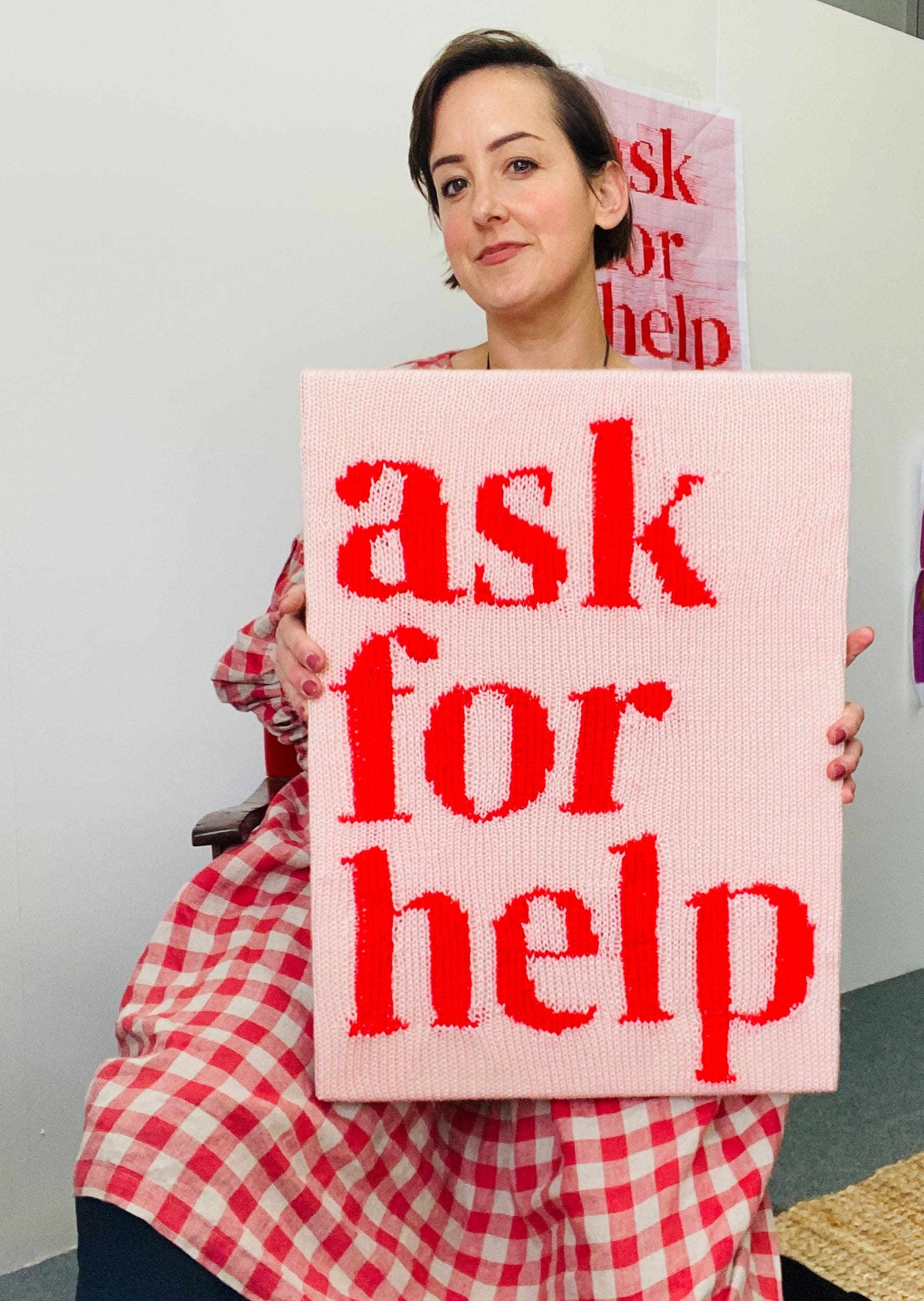
Sometimes self-care requires effort which can feel difficult when you’re not feeling up to it. What would you say to people feeling this way?
I would say don’t feel guilty if self-care feels hard. In the ‘wellness industry’ sense, self-care is often advertised in capitalist terms as things we can attain or treats that we deserve. But self-care doesn’t fix structural oppressions many people face. In the face of lived challenges, self-care is most radical when we make space in an ongoing way to reflect upon who we are, what we need and want, and how this is affected by the conditions we live within, and make decisions and actions from that base.
If self-care and self-knowledge feels overwhelming or impossible, and the way forward feels precarious, then it is a great idea to reach out for help—to a friend, a counsellor, or a helpline such as Lifeline 13 11 14 or Beyond Blue 1300 224 636. We can nurture ourselves, but it is not our job to do it alone. That was why “ask for help” was my first self-care panel and “accept care” was my last.
Quick advice for young artists?
Most of my advice for artists is also in my Self Care Action Series: play, listen to yourself, stay present, feel your feelings, make art, learn something new, have an adventure, look at art!
Best time of day to create?
Between 9pm and 1am when everyone else in my house is in bed and I am still working. I work at other times of the day, but this time is just for me!
Are you a good cook? Any signature dishes?
Let’s be honest; not really. My wife Paula is the far better cook. But I love food and I think about food a lot. However, children really like the food I make. My signature ‘child pleasing’ dish has become the American stack—at least five pancakes stacked on top of each other with butter in between them and drenched in maple syrup.
An art experience that’s stuck with you?
In 1997, I crawled through an amazing work by Lygia Clark at Fundacio Antoni Tapies in Barcelona. It was a wooden framed entry but when you crawled through, it was like navigating a birth canal. There was rope and toys and material approximating hair at the exit. It was 27 years ago but I remember it like it was yesterday. I felt like I was being born from out of the dark. It was fun and playful and took me to another place. I understood how great and exciting art could be. I didn’t go to art school until 2000 at the age of 26, but it influenced me and my thinking.
Is there a particular time and place you like to knit? In the studio? In front of the TV?
I love knitting new work in my studio, because I love the solitude and being in my own space to contemplate my work. But at night after everyone is in bed, and I’m at home on the couch with our toy poodle Pearl curled up, I often work on things till the late hours of the night while watching TV series, or listening to audio books or podcasts. Both spaces give me a pleasurable sense of time just for me. In the arts there’s growing focus on women, queer and Indigenous artists and artists of colour.
How are you feeling about the potential for structural change, in the arts and life?
I’m really excited to see this renewed focus, but I don’t think we should suddenly relax and believe that everything has suddenly changed. While there is more equitable programming in exhibitions and grant opportunities for artists, there is still a lack of gender and racial equity in museum staff and boards, as well as with auction and sale prices, and in what gets collected and put on permanent display.
Is there a dream knitted work you’d like to make?
I have been making all the work I dream of all along! If I had endless budget and resources, I would probably like to make a giant knitted outdoor work similar to the monstrous knitted, pink bunny on the Italian hillside by Gelitin [a Viennese art collective]. Maybe a knitted or textile-based rainbow!
Self Care Action Series
Kate Just
Linden New Art (Melbourne VIC)
Until 4 June